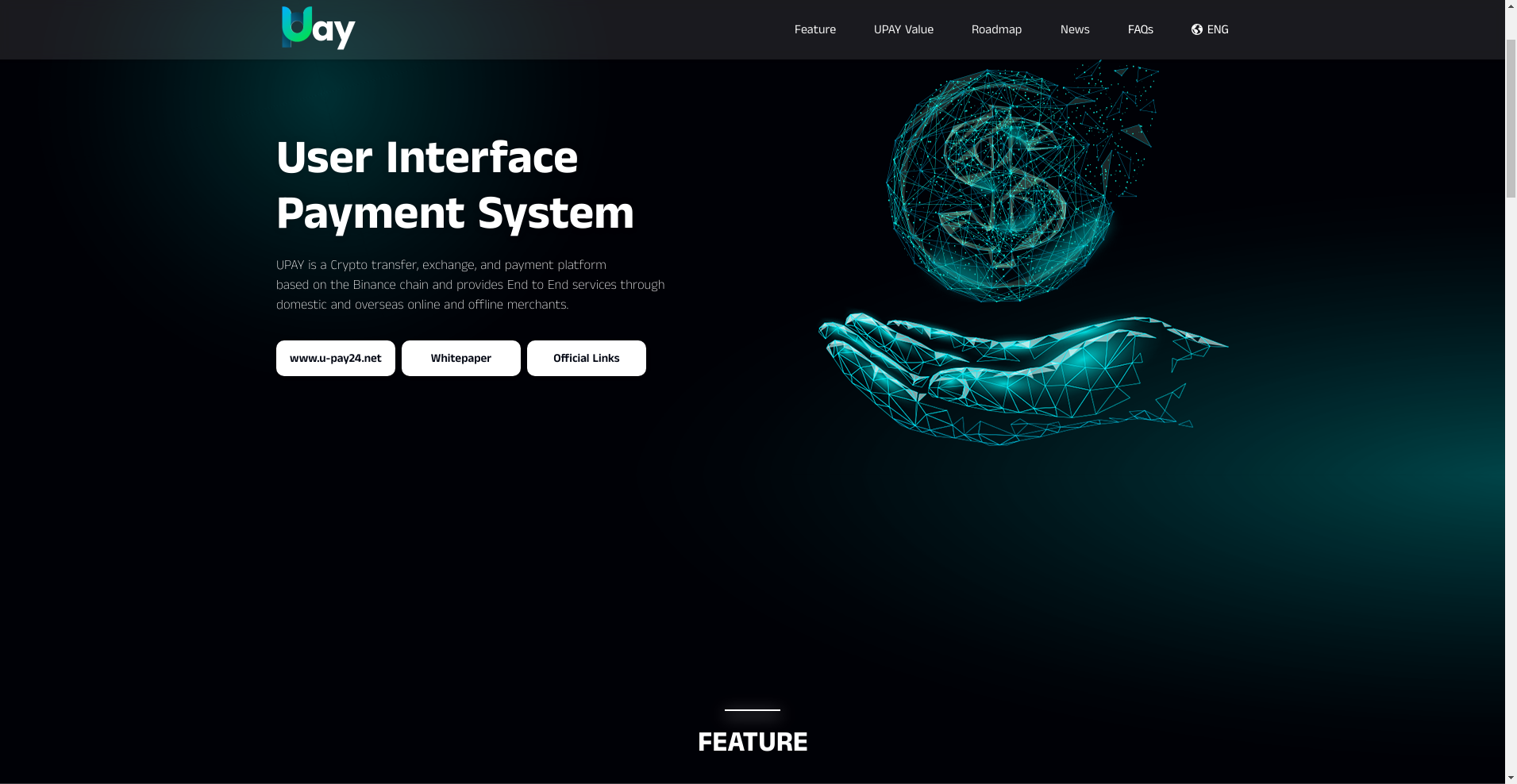User Interface Payment System ($UPAY) Review: A Data-Driven Legitimacy and Risk Assessment

Project Overview
The User Interface Payment System (UPAY) is a cryptocurrency platform designed to facilitate end-to-end payment services on the Binance Smart Chain (BSC). According to its official communications, UPAY aims to connect digital assets with real-world assets, offering remittance, exchange, and payment solutions suitable for both online and offline merchants globally. The project emphasizes reducing transaction fees, lowering double payment risks, and bridging cryptocurrency payments with fiat settlements.
This article offers an impartial analysis of UPAY's core claims, technical foundation, and operational prospects. The assessment is grounded on publicly available audit results, on-chain data, tokenomics, and ecosystem activity, with particular focus on potential strengths, vulnerabilities, and risks that an investor or user should consider.
The Team and Vision Behind User Interface Payment System
The publicly available information provides limited detail regarding the core team members' identities or prior experience. The project's website and associated social channels, including Telegram and Twitter, lack detailed bios or verified credentials for the founding team or technical developers. The audit report confirms development progress but does not specify individual contributors or project leadership.
Its roadmap indicates key milestones such as branding, wallet development, token launch, and strategic partnerships—particularly with global Payment Gateway companies. Since these milestones span over a year, the project's projected trajectory appears cautiously optimistic but depends heavily on execution and establishing trust in its ecosystem.
- Systematic token issuance in Q2 of 2024 aligns with strategic partnership goals.
- Expansion plans for global online and offline merchant connections suggest long-term vision.
Given limited transparency about the team’s credentials and a roadmap that relies on scaling partnerships, the project's ability to deliver on its promises remains contingent upon execution risk and strategic alliances.
Assessing the Security and Integrity of User Interface Payment System
The security evaluation is based solely on the Cyberscope audit report, which assesses the UPAY smart contract deployed on BSC. The audit confirms a formal review of the code but reveals a notable critical issue related to high-criticality vulnerabilities. Specifically:
- The audit indicates the presence of at least one critical vulnerability, suggesting potential contract exploitation risks.
- The overall security score is high at 88 out of 100, with a percentile ranking near 88%, reflecting generally strong security measures.
- Audit scope includes token contract assessment, yet detailed vulnerability descriptions are not publicly disclosed in the summary.
- No mention of centralized controls or upgradeability mechanisms is noted, raising concerns about potential single points of failure.
While a high security score provides some confidence, the acknowledged critical vulnerabilities imply that the system might be vulnerable to exploits if not addressed. For investors, this underscores the importance of reviewing ongoing security patches and community developments before engagement.
A Breakdown of User Interface Payment System Tokenomics
The UPAY token, central to its ecosystem, was launched in Q2 2024 as part of its strategic growth plan. From the audit data, the token standard appears aligned with typical BEP-20 tokens on BSC. The tokenomics, although not fully detailed publicly, can be inferred as follows:
- Total Supply: Data not explicitly provided; presumed to be fixed or inflationary based on standard token practices.
- Distribution: No specific allocation breakdown is available; potential allocations include team, advisors, partnerships, or community incentives.
- Vesting Schedules: Not clearly disclosed, raising questions about immediate token liquidity or lock-up periods.
- Utility: The $UPAY token is intended for use within the payment ecosystem, including transaction fee discounts, staking rewards, and potentially governance participation.
- Inflation/Deflation: Absent explicit details; the project's economic sustainability hinges on controlled issuance or buy-back mechanisms.
Without concrete tokenomics data, it is challenging to assess the project's economic sustainability or potential for inflation-driven value dilution. Risks inherent to early-stage token models include hyper-issuance and imbalance between supply and demand. Understanding token distribution and vesting schedules is crucial for evaluating such projects.
Assessing User Interface Payment System's Development and Ecosystem Activity
Development activity, as reflected in the latest GitHub uploads and community reports, indicates that UPAY has completed its initial phases, including branding, wallet system construction, and the launch of its core features in 2024. The project has also announced partnerships with global Payment Gateway providers and wallet companies, suggesting an active effort to integrate with existing financial infrastructure.
However, visible on-chain activity and trading volumes remain minimal, with zero recorded trading volume at present, implying limited market adoption or liquidity. The presence of a Telegram community with over 13,400 members indicates good community interest, but activity levels and engagement quality should be independently verified for substantive ecosystem traction.
From a developmental perspective, the project continues to expand its online payment ecosystem, but the lack of real-world transactional data and operational user metrics limits the assessment of genuine usage versus marketing claims. The effort to bridge crypto and fiat for merchant payments is a key focus for UPAY.
The Fine Print: Analyzing User Interface Payment System's Legal and Terms Framework
There is limited publicly available information on the project’s legal documentation, such as terms of service, privacy policies, or compliance disclosures. The official website provides basic feature descriptions but lacks detailed legal clauses. No mention of regulatory compliance, KYC procedures, or dispute resolution mechanisms is evident, which may present risks related to legal uncertainty.
Potential issues include:
- Absence of transparent legal framework for user funds and data handling.
- Unclear licensing or jurisdictional restrictions.
- No explicit KYC/AML procedures, which could affect regulatory standing in sensitive markets.
These factors suggest that, for a user or investor, caution is warranted until comprehensive terms are published and compliance measures are clarified.
Final Analysis: The Investment Case for User Interface Payment System
Overall, UPAY presents itself as a promising platform aimed at integrating cryptocurrency payments with real-world assets via its BSC-based infrastructure. The project demonstrates developmental progress and community engagement but faces notable challenges around transparency, security vulnerabilities, and market adoption. Its reliance on partnerships and unspecified tokenomics introduces uncertainties about long-term viability and economic sustainability.
While the security audit indicates a robust overall score, the critical vulnerabilities highlighted suggest ongoing risk of exploitation if not addressed adequately. Moreover, the lack of detailed legal and compliance disclosures introduces additional legal and operational risks, especially for users handling sensitive transaction data or funds.
Pros / Strengths
- Active development with recent milestones achieved.
- High security score with formal audit assessment.
- Growing community presence (Telegram, Twitter).
- Focus on bridging crypto and fiat markets with real-world utility.
Cons / Risks
- Limited transparency regarding team credentials and detailed tokenomics.
- Detected critical vulnerabilities in smart contracts that require ongoing remediation.
- Minimal on-chain transactional activity and trading volume.
- Lack of clear legal, KYC, and compliance disclosures.
- Risks related to early-stage ecosystem adoption and market competition.
In conclusion, UPAY’s potential hinges on successful execution of its roadmap, resolution of technical vulnerabilities, and establishing regulatory legitimacy. Stakeholders should weigh these documented strengths and risks carefully before considering participation or investment, recognizing that the project remains in its developmental infancy with notable uncertainties.

Jessica Taylor
NFT Market Data Scientist
Data scientist specializing in the NFT market. I analyze on-chain data to detect wash trading, bot activity, and other manipulations that are invisible to the naked eye.
Similar Projects
-
BoredSpace
Crypto Scam Checker Review: Is BoredSpace a Legit Project or Scam?
-
Zeebu
Comprehensive Review of Zeebu: Is This Telecom Blockchain Project a Scam or Legit?
-
Enjin Coin
Enjin Coin Review: Scam Check & Legitimacy Analysis
-
Peppino
Crypto Scam Checker Review: Is Peppino a Legitimate Project or a Scam?
-
RoiFeed
RoiFeed Review: Crypto Project Scam Checker & Analysis